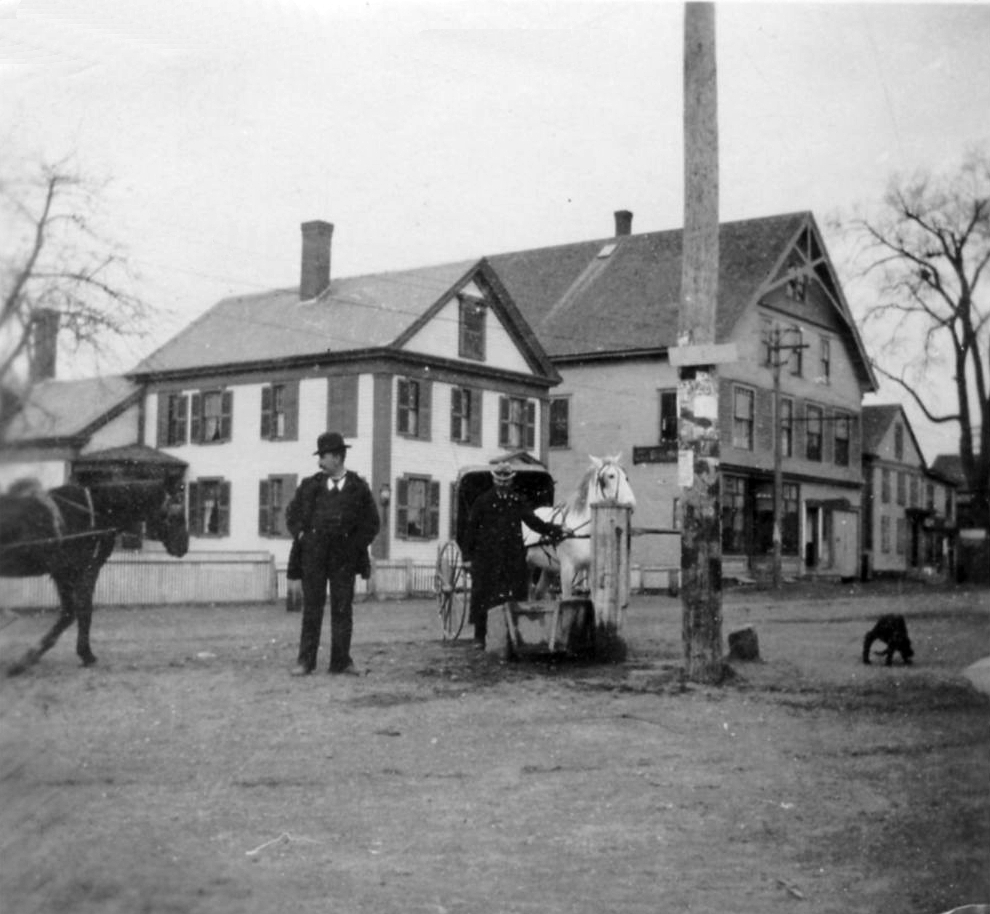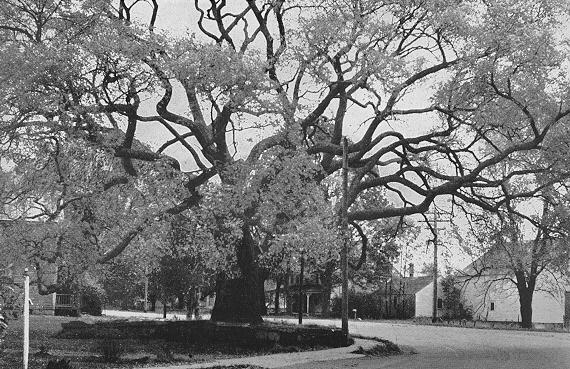
“Our Town” by James W. Tucker
The Hampton Union — Thursday, August 10, 1961

[First building in photo is now the “Goody Cole Function Room” of “The Old Salt Eating & Drinking Place”, formerly “Lamie’s Tavern”.]
There has been quite a commotion of late concerning the business section of Hampton village which now centers on Lafayette Road and the west end of High Street. During the recent hilarious hassle over a site for our town’s new post office, the Planning Board suggested, in effect, that future business development of Lafayette Road, between High Street and Winnacunnet Road, be held in abeyance pending a study of parking and traffic conditions. The present shopping center would have been left to wither on the vine of progress.
Buildings, Stores and All
A little more than half a century ago, the village business section was moved lock, stock and barrel from the east end of Exeter Road to Lafayette Road. Buildings, housing various types of business enterprises, were moved to the present shopping center, probably because Towle’s Crossing — where the railroad tracks crossed Exeter Road — was becoming increasingly dangerous. The easterly end of Exeter Road was then called Main Street and a railroad, barging across the main street of an up and coming village, presented many problems back in those horse and buggy days.

at left and Dr. Marvin Smith on right, with “old Dobbin” at extreme left of photo.
No Planning Boards
There were no planning boards in the era of kerosene lamps, so, in all probability Hampton store-keepers got together in Deacon Lane’s grocery, which then occupied the building which now houses the Tavern’s Goody Cole room, and decided to move around the corner onto historic Lafayette Road. Or, it may have happened spontaneously.
Politician – President
In any event, on Aug. 28, 1899, the B. & M. Railroad, through its famous politician – president, Lucius Tuttle, petitioned the N.H. Board of Railroad Commissioners to separate the grades at Towle’s Crossing by having the highway pass BELOW the railroad. The petition was granted and a hearing ordered for Sept. 16, 1899 to be held in the Hampton Passenger Station at 11:30 o’clock in the forenoon. After a notice for the hearing had been posted, it was evidently noted that the petition contained several errors. The road or street upon which the crossing was located had not been specifically mentioned and obviously the highway could not pass below the railroad.
Above Instead of Below
So another petition, dated Sept. 16, 1899, was drawn up, stating that the railroad “crosses, at grade, a highway, known as the Exeter Road, or Main Street and that it is for the public interest . . . . . that the grades of said highway and railroad . . . . . be separated, by having the said highway pass ABOVE said railroad, at said Crossing.” The Railroad Commissioners ordered another hearing at the same place for Oct. 12, 1899 at 12:30 p.m. It was held and the petition granted. The overhead crossing was constructed and Main Street was no longer the village main street. Lafayette Road became the main street of the village and has remained the main street ever since. And, our planless Planning Board to the contrary notwithstanding, it probably will remain the main business thoroughfare of the village section of our town for some time to come.
Railway to Highway
When the railroad — known in Lucious Tuttle’s time as the B & M Eastern division — finally gives up the ghost as it probably may in ten or fifteen years, the rails may be torn up and the roadbed, together with the right of way on either side, used for a highway by-pass around the village shopping center. That stretch of rails, from the overpass south of the village to a similar overpass just north of town, would be much more useful to this community as a highway than it is, under present circumstances, as a railroad. If it could be used by through traffic, including the numerous, noisy, smelly trucks, the summertime press of cars in the village shopping center would be greatly lessened.
In the meantime perhaps a plan can be worked out involving a lessened toll charge which will get trucks off Lafayette Road and onto the N.H. Turnpike where they belong. That would be a great help. In addition, the use of Mill Road as an alternate summertime route for through traffic going in both directions, might at least be given a little study.
Three Traffic Lanes
The traffic and parking suggestions printed here and elsewhere which have not already been adopted, could be given more serious thought, along with the oftentimes repeated idea of three traffic lanes on Lafayette Road between High Street and Rice Terrace with the center lane marked plainly for northbound traffic desiring to turn left into either the Tavern or the First National Store. If this plan were ever tried out, it would be necessary to ban parking down the east side of Lafayette Road, at least from High Street to Rice Terrace.
Practical Action
It will never again be possible to shift the village shopping center — lock, stock and barrel — as was done at the end of the last century when the town’s main street was moved to Lafayette Road. Therefore, official Hampton had better keep busy in a really serious effort to alleviate traffic and parking conditions in the village center. A little practical action is far better than a lot of impractical planning.
The Hampton Elms

That patriarch of trees, the historic Hampton Elm, which once cast its umbrella of shade over all of Elmwood Corner and many adjoining yards, is gone — the victim of Dutch Elm disease. Many others of the stately elms that have graced Hampton’s highways and by-ways for centuries have likewise gone and the remainder will soon be gone — just as the chestnut trees of our boyhood have completely disappeared.
Arboreal Miracle
Could they have been saved? Can the remaining elms be saved? We don’t really know. It will take some kind of arboreal miracle. Years ago we stood in a mid-western town and watched the removal of hundreds of comparatively young elms, victims of the Dutch Elm disease. The manager of the town told us that the scourge would soon cross the Appalachians and we came home and wrote about the danger in this column.
Scourge Skips Boundaries
We have written about it many times since, and much has been done in an endeavor to cope with the deadly disease — but not enough. We grant that to do enough might be prohibitive by reason of the cost involved. How can the dollars and cents value of a beautiful, stately elm be correctly estimated, especially by an overburdened taxpayer? And what does it profit Hampton to spend the money necessary to save her elms if neighboring towns do nothing or only a very little in an attempt to save theirs? The scourge skips lightly across town and state boundaries.
Cooperative Effort Needed
If every town in every New England state would work efficiently to save its elms, the disease might possibly be eradicated. The June issue of the Massachusetts Forest and Park has some sensible advice for the control of Dutch Elm disease, emphasizing sanitation: “Sanitation does not start and stop with the removal of diseased trees. A year ’round program of removing dead and dying branches and broken limbs from otherwise healthy trees eliminates the breeding areas for the elm bark beetle. Three steps are recommended by the Forest and Park association for Dutch Elm disease control, listed in decreasing order of importance;
“1. Scouting to locate dead and dying elm wood.
2. Prompt removal of such wood.
3. spraying as needed to control attacks of leaf eating insects. sprays should be carefully applied to minimize the danger to wild life.”
As we write, a glance out of the window brings to view the stark skeletons of two fifty-foot elms which only two year ago were majestic ornaments to Lafayette Road. Scouting is not required to locate dead and dying elm wood in our town. It is plainly to be seen almost everywhere here and in neighboring communities.